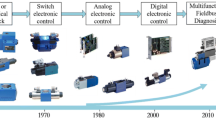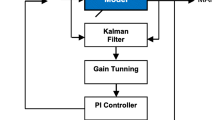Abstract
Cardiovascular diseases are the leading cause of deaths worldwide, causing more than 15.2 million deaths in 2016 alone. Thus, the need for intervention is clear so that these worrying numbers can be reversed. In this sense, a collective effort is needed in the areas of research and development of treatments for these cardiopathies. The purpose of this work is to develop a microcontrolled didactic bench that reproduces the behavior of the human circulatory system (HCS). The prototype will be able to elucidate the concepts involved in the dynamics of the flow and blood pressure of the systemic circulation. The basic elements that constitute the bench are a reservoir, a compliance chamber, a hydraulic piston pump driven by a direct current motor and a gate valve. All actuator elements and sensors are interconnected by a control system that can be accessed by a computer. The hydraulic circuit is based on the Windkessel model, which explains the transformation of the pulsatile flow of the heart into a virtually constant flow. The bench is capable of simulating scenarios of this phenomenon with parametric pressure variations between 40 and 210 mmHg and heart rate from 70 to 100 bpm. After the development of the bench, it was subjected to tests with fixed values of ejection volume and engine rotation for hypotension, normotension and hypertension, according to the norm ISO 5840-3:2013. The experimental data obtained from the bench were compared to the values of the systolic and diastolic pressure ranges reported in the literature.
Access this chapter
Tax calculation will be finalised at checkout
Purchases are for personal use only
Similar content being viewed by others
References
Naik KB, Bhathawala DPH (2014) Mathematical modelling and simulation of human systemic arterial system 4:1–7
Gregory SD Simulation and development of a mock circulation loop with variable compliance, p 174
Silva AG, Goroso DG, Silva RR (2019) HCSSim: a simulator of elastic arterial vessels using Windkessel models. In: González Díaz CA, Chapa González C, Laciar Leber E, Vélez HA, Puente NP, Flores D-L et al, organizadores (eds) VIII Latin American conference on biomedical engineering and XLII national conference on biomedical engineering [internet]. Springer International Publishing, Cham [citado 12 de outubro de 2019], pp 709–717
Silva AG, Goroso DG (2019) HCSSim: Um Simulador Do Sistema Circulatório Humano Utilizando Circuitos Elétricos Equivalentes 4
Westerhof N, Lankhaar J-W, Westerhof BE (2009) The arterial Windkessel. Med Biol Eng Comput. 1o de fevereiro de 47(2):131–141
Oliveira BRF (2011) Circuito hidráulico mimetizador de ejeção do ventrículo esquerdo e de pressão no interior da aorta. Universidade Federal do Rio de Janeiro
ISO 5840-3:2013(en), Cardiovascular implants—Cardiac valve prostheses—Part 3: Heart valve substitutes implanted by transcatheter techniques [Internet]. [citado 14 de junho de 2020]. Disponível em. https://www.iso.org/obp/ui/#iso:std:iso:5840:-3:ed-1:v1:en
Okuno E, Caldas IL, Chow C (1986) Física para ciências biológicas e biomedicas. Harbra, 490 p
Acknowledgements
The authors are grateful for the financial support of the University of Mogi das Cruzes (OMEC/UMC) and the Foundation for Research Support of the State of São Paulo (FAPESP) Grants #2013/20220-5 and #2016/18422-7.
Conflict of Interest
The authors state that there are no undisclosed financial or personal relationships that might results in conflict of interest with respect to this study.
Author information
Authors and Affiliations
Editor information
Editors and Affiliations
Rights and permissions
Copyright information
© 2022 Springer Nature Switzerland AG
About this paper
Cite this paper
Silva, A.G. et al. (2022). Development of a Hydraulic Model of the Microcontrolled Human Circulatory System. In: Bastos-Filho, T.F., de Oliveira Caldeira, E.M., Frizera-Neto, A. (eds) XXVII Brazilian Congress on Biomedical Engineering. CBEB 2020. IFMBE Proceedings, vol 83. Springer, Cham. https://doi.org/10.1007/978-3-030-70601-2_148
Download citation
DOI: https://doi.org/10.1007/978-3-030-70601-2_148
Published:
Publisher Name: Springer, Cham
Print ISBN: 978-3-030-70600-5
Online ISBN: 978-3-030-70601-2
eBook Packages: EngineeringEngineering (R0)




